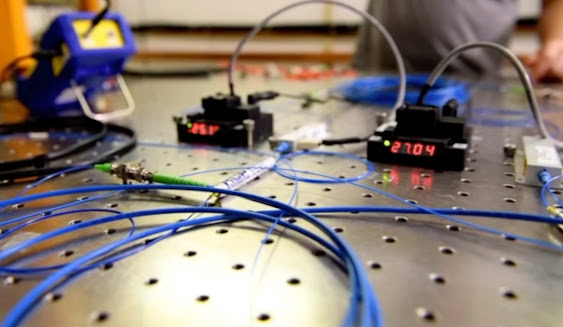Although the distance record was not decided by quantum teleportation, for the first time it was possible to transmit the state of a qubit to an optomechanical device, which is a significant step forward in establishing a functioning quantum Internet.
The peculiar phenomenon of quantum teleportation, which allows the 'sender' to send the state of a quantum bit to any distance, even without knowing the exact location or state of the qubit, has been proven in countless experiments, even over ever greater distances. Teleportation is based on the entanglement of qubits: due to the inseparable state of the particles in this position, the change in the position of one party occurs in the other, so that information can theoretically be transported any distance.
Using this phenomenon, the quantum internet networks of the future will be built, which will implement a completely different way of transmitting information than the currently used systems, but it is possible that the already established fiber optic cable networks will form the basis of the quantum internet. In December 2020, Fermilab researchers transmitted photon qubits over 44 kilometers of traditional optical fiber with more than 90% accuracy, laying the foundations for an urban quantum network around Chicago, according to Panagiotis Spentzouris, head of Fermilab's quantum science program.
However, in order for information to be transmitted not only locally but also over really long distances, it is necessary to have repeaters, units that keep the state of the qubits in their memory for a while, and then read it from there to send it to more distant points on the network. These nodes are essential to building a truly functional system, but storing information is not an easy task. Researchers at TU Delft and the University of Campinas have now experimented with a new approach :
an optomechanical device, silicon resonators, was used as a node.
Optomechanical devices differ from conventional mechanical devices in that they detect and transmit the mechanical effect by means of light. Keyboards based on this principle, such as the Razer Huntsman, detect motion through a connection between an infrared transmitter and receiver when the key is pressed, and the path of light is interrupted when the key is returned to its original position.
The researchers teleported any quantum state of a photon to the optomechanical memory device, whose ten-micrometer resonators were made up of billions of atoms and later the stored information could be read from the device. This method may allow the quantum Internet to run on the optical cables currently in use, as optomechanical devices can be operated at any optical wavelength, including the infrared ranges used for telecommunications purposes in optical fibers.
"This is the wavelength that results in the lowest transmission loss and allows the greatest distance between repeater nodes."
- said Simon Gröblacher, TU Delft researcher - "The future quantum internet will undoubtedly apply the existing telecom networks at this wavelength."



